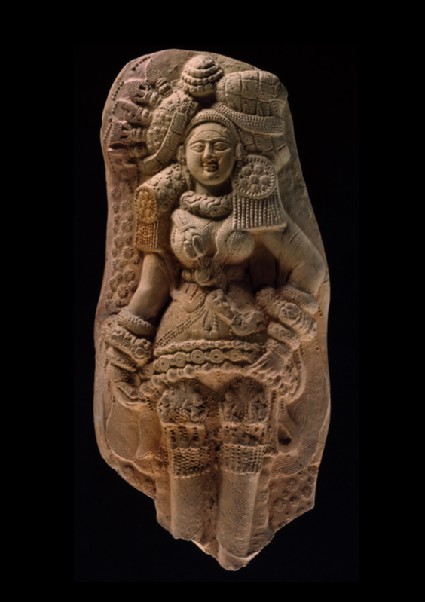Search Results: objects
Show search helpPlaque with yakshi (nature spirit) or mother goddess
-
Description
Terracotta moulded plaque. Exceptional for its elaborate ornament and fine detailing, this famous terracotta was discovered in 1883 in a river bank at Tamluk, the ancient sea port of Tamralipti on the Bay of Bengal.
-
Details
- Associated place
-
Asia › India › east India › West Bengal › Tamluk (find spot)Asia › India › east India › West Bengal › Tamluk (place of creation)
- Date
- 2nd century BC (200 - 101 BC)
- Material and technique
- terracotta, moulded
- Dimensions
- 21.7 x 10.2 x 4 cm max. (height x width x depth)
- Material index
- Technique index
- Object type index
- No. of items
- 1
- Accession no.
- EAX.201
-
Further reading
Harle, J. C., and Andrew Topsfield, Indian Art in the Ashmolean Museum (Oxford: Ashmolean Museum, 1987), no. 7 on pp. 6-7, p. 8, pl. 2 (colour) & p. 7
Penny, Nicholas, The Materials of Sculpture (New Haven: Yale University Press, 1993), p. 168
Bradford: Bradford Art Galleries and Museums, 24 September-27 December 1988, and London: Zamana Gallery, 13 April-25 June 1989, A Golden Treasury: Jewellery from the Indian Subcontintent, Susan Stronge, Nima Smith, and J. C. Harle, eds., Victoria and Albert Museum Indian Art series (London: Victoria and Albert Museum in association with Mapin, 1988)
Untracht, Oppi, Traditional Jewelry of India (New York: Harry N. Abrams, 1997), p. 691
Postel, M., Ear Ornaments of Ancient India, Project for Indian Cultural Studies, 2 (Bombay: Franco-Indian Pharmaceuticals, 1989), p. 2
Lynton, Lynda, The Sari: Styles, Patterns, History, Techniques, photographs by Sanjay K. Singh (London: Thames and Hudson, 1995), p. 10
D. K. Chakrabarti, ‘Post-Mauryan States of Mainland South Asia (c. BC 185-AD 320)’, F. R. Allchin, ed., The Archaeology of Early Historica South Asia: The Emergence of Cities and States (Cambridge: Cambridge University Press, 1995), pp. 324-325, illus. p. 325 fig. 12.23:1
Oxford: Ashmolean Museum, 24 May 2006-23 December 2008, Treasures: Antiquities, Eastern Art, Coins, and Casts: Exhibition Guide, Rune Frederiksen, ed. (Oxford: Ashmolean Museum, 2006), no. 30 on p. 14, illus. p. 14 fig. 30
Ahuja, Naman, ‘Early Indian Art at the Ashmolean Museum - Catalogue in progress’, 2016, no. 136
Glossary
yakshi
-
yakshi
A semi-divine female nature spirit.
Location
Objects are sometimes moved to a different location. Our object location data is usually updated on a monthly basis. Contact the Jameel Study Centre if you are planning to visit the museum to see a particular object on display, or would like to arrange an appointment to see an object in our reserve collections.
Galleries
Publications online
-

Indian Art in the Ashmolean Museum
Through the ages, terracotta has been formed the medium for some of India’s most important and beautiful sculpture (see, for exmple, [EA1972.45, EAOS.50, EAOS.50A and EAX.215]). One distinctly Indian type, although probably ultimately derived from western Asia, is the small upright plaque bearing a single moulded figure, usually a woman, or more rarely a couple, man and woman (mithuna). The so-called “Oxford plaque” is the finest and best preserved of these plaques which have been found at many sites in northern India, from the north-west to Bengal. The female figures are distinguished by certain common features of dress; a huge bi-or tri-cornate headdress, the large bolster-like ear-rings and the massive tubular bracelets. Strangely enough, these articles of dress appear on contemporary metal effigies on women [EA1973.7] but never on stone reliefs.
The Oxford terracotta is also exceptional, in that both the exact location and the time of its finding, in 1883, are recorded, long before similar but fragmentary examples surfaced in excavations in the same area near Calcutta after World War II and revealing by their identical style that here was a distinct Bengali sub-style. The beauty of this plaque lies largely in the exquisite fineness of detail made possible by impression on a faultless matrix of well-levigated clay. After impression by the mould, doubtless also of terracotta, details like the rosettes on the ground were added by poinçon and the lines indicating drapery scratched on. Some of the detail, such as the deer and makara buckles on the sash across the figure’s torso, while perfectly executed are so small they can hardly be seen by the naked eye. A makara is a mythical monster [see EA1971.13]. Aesthetically, there is a curious contrast between the figure’s plump and sensuously modelled arms and her stick-like legs, while the general air of barbaric splendour is quite outside the mainstream of Indian art.
Various identifications have been proposed for this and similar figures. One of these is a yaksī, the female counterpart of a yaksa or local godling. At one level high-born ladies of the time and it is known from stone reliefs that male figures without any particularly distinguishing attribute could represent Hindu gods or great figures of early Buddhist story. On the other hand, it is possible that they represent mother-goddess, whose cult was widespread; their veneration at a popular level would account for the large number of these plaques. A terracotta of a pregnant woman (seated) wearing a bi-cornate headdress from the north-west in the Peshawar Museum further suggests such an identification.
© 2013 University of Oxford - Ashmolean Museum



